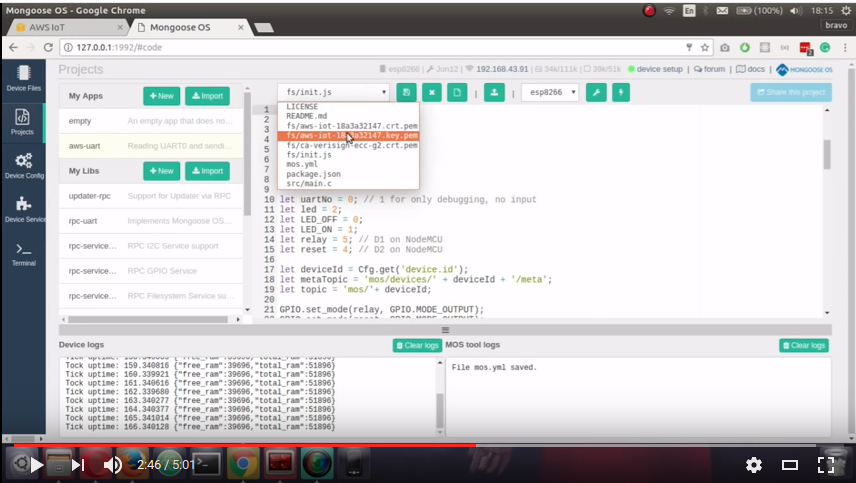https://github.com/mongoose-os-apps/aws-uart
https://github.com/mongoose-os-apps/aws-uart
aws esp8266 iot mongoose-os uart
Last synced: 5 months ago
JSON representation
- Host: GitHub
- URL: https://github.com/mongoose-os-apps/aws-uart
- Owner: mongoose-os-apps
- License: apache-2.0
- Created: 2017-06-12T23:38:52.000Z (over 8 years ago)
- Default Branch: master
- Last Pushed: 2020-08-20T19:02:53.000Z (over 5 years ago)
- Last Synced: 2025-04-23T21:44:35.223Z (8 months ago)
- Topics: aws, esp8266, iot, mongoose-os, uart
- Language: JavaScript
- Size: 19.5 KB
- Stars: 6
- Watchers: 6
- Forks: 3
- Open Issues: 0
-
Metadata Files:
- Readme: README.md
- License: LICENSE
Awesome Lists containing this project
- awesome-mongoose-os - aws-uart
README
# Mongoose OS & AWS IoT - UART and Thing Shadow example (Javascript)
## Overview
This app does two things.
- Reading UART 0 of ESP8266 and sending it to AWS IoT
- Sending device metadata and two pins state to AWS IoT
## How to install this app
## Step 1: Import
##### Via MOS UI tool
- Install and start [mos tool](https://mongoose-os.com/software.html)
- Switch to the Project page, find and import this app(if available otherwise follow the steps below), build and flash it:

##### Flash the app through command line
- Clone this repo ```git clone https://github.com/mongoose-os-apps/aws-uart```
- Go into the directory `aws-uart` and run `mos build --arch esp8266` ( Change the arch respectively )
- After that, you should see a **build** directory in the current directory which will have the `fw.zip` binary
- Run ```mos flash``` which flashes the current build
- Run ```mos console``` and check
## Step 2: Set up Wi-Fi
- You can do this via mos tool UI or use command `mos wifi WIFI_NAME WIFI_PASSWORD`
Note that `mos` talks to the device using RPC mechanism.
RPC can talk over serial (uart), http, mqtt. By default, `mos` talks via uart.
but aws-uart example takes over uart, therefore mos RPC does not work.
You need to use another RPC channel - for example websocket. Therefore,
update `mos.yml`, put your wifi credentials there, then build/flash,
see what IP address is assigned to your board, and start mos as
`mos --port ws://IP_ADDRESS/rpc`.
## Step 3: Set up and Provision AWS IoT thing, Policy
- You can do this via mos tool UI or use command `mos aws-iot-setup --aws-iot-policy mos-default`
- Create a thing in AWS IoT and you are done
- Test this by going into AWS IoT MQTT test Console by subscribing to `mos/#` with QoS 1
### Video
[](https://www.youtube.com/watch?v=2zZWANSQKqg "Mongoose OS + AWS IoT")